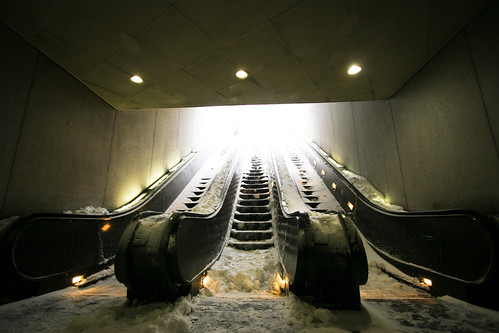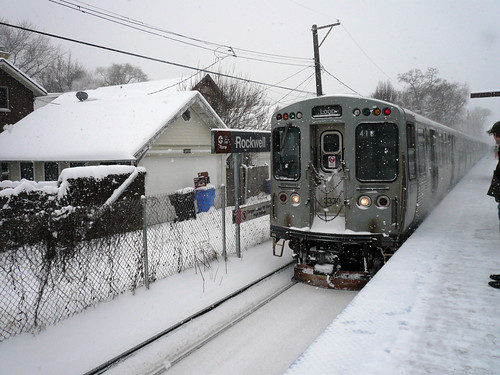
‘South Smithsonian Escalators’
courtesy of ‘william couch’
It’s going to be in the sixties and sunny for the next few days, and memories of record snowfall and Metro closures are quickly fading. But I want to take you back a month, to twenty-inch snowfalls and closed federal offices. Every time that we’ve had a massive snowfall in the area over the last 22 years that I’ve been here, someone suggests that Metro should buy equipment to deal with big snow falls. And every time the idea gets shot down with an argument about how we can’t afford to be prepared for once every seven years/decade/lifetime storms.
With each mounting inch of snow, and each dollar that it costs to dig out, I began to doubt that, and I decided to see how much it costs to buy equipment that might help Metro fight the snow. I contacted the friendly folks at the Chicago Transit Authority and asked them about their equipment and what they do to handle the snow.
Metro closes all above ground stations when snow reaches between six and eight inches. They do this to protect the undercarriage of the trains and for fear that trains won’t be able to get power from the electrified third rail. In contrast, CTA has no such predetermined parameters and try and maintain normal service until it is unsafe to do so.

‘Like The Post Office…’
courtesy of ‘ChiBart’
They manage this by using a combination of snow fighting tools: plows on the front of trains, ice scrapers on each of 1190 rail cars for scraping ice and sleet from the third rail, de-icing equipment on 182 rail cars to fight the formation of ice in the first place. On top of that, CTA has four diesel-powered snow fighter locomotives “with a snow blower at one end and a rotating broom at the other that are capable of removing snow in excess of eight inches from all rail system tracks.”
So what would it cost to equip Metro with similar capability? Surprisingly, it’s not as much as I would have thought considering the number of times the idea was dismissed during my years here. I’d like you to keep in mind that these numbers are for Chicago’s system, and that the two systems do not have identical rail cars. CTA also manufactures some of their snow fighting equipment themselves (like the de-icing equipment), and none of these numbers include the cost of labor or maintenance.
With that out of the way, let’s take a look at the big ticket items, those diesel snow blowing trains. CTA bought theirs years ago, and prices then aren’t what they are now, but they were kind enough to tell me that current pricing for similar locomotives would be between $1.8-$2 million a train. Assuming Metro were to get the same number of these locomotives (which is to say, assuming on the high side), that’s $8 million.
CTA tells me that the cost of rail car snow plow blades depends on the car model, either $365 or $490. Again, I’m going to assume that WMATA’s rail cars will require the more expensive plows, and that you will need to fit two on each of 140 trains. That’s a high side estimate of about $140,000.
The ice and sleet scrapers are $210 per rail car, and to buy enough for Metro’s approximately 850 cars that are used during rush hour would cost $178,500. If we bought enough for the entire fleet of 1126 rail cars, the cost would be just under a quarter million dollars.
Again, if we round way up, it looks like it would take about $10 million to equip Metro with enough snow fighting equipment to keep going through a Chicago winter. That’s 38″ of snow a season, on average.
Metro’s storm losses (between December and February) will amount to over $20 million. They will recoup most of that money from FEMA, so maybe FEMA should consider helping the system be prepared for the next big snow? Even better, the supposed cost in lost productivity for each day the Federal government is closed is $100 million. If having a working Metro could have meant one less day of closures, this equipment will have paid for itself ten times over.
Maybe, just maybe, instead of paying for the damage Mother Nature hands out we could spend a fraction of that cost on preparing for her wrath.
Awesome analysis! Thanks Samer!
Metro lost $20 million, but I’m not sure all of that was because they stopped above ground service. The whole region lost revenue because people stayed home, didn’t go to the malls and didn’t go to the movies, etc. And the cost of continuing operations in 20″ of snow is above the shopping list for equipment for the trains. I doubt Metro possesses the equipment necessary to make above ground stations accessible in a timely manner when 20″ of snow falls.
Now, the next time we have a 7″ snowfall and Metro shuts down for half a day, I’d like to see what the revenue numbers look like for that. I’m guessing the loss might be less than the cost to revise the policy.
If Metro was swimming in cash, sure. And while we’re at it, how about oriental rugs, velvet upholstery and polished wood in the cars?
Good job looking up numbers, but there’s no way Metro can afford any of that.
Besides, metro shut down = snow day = fun.
@Lou,
Metro’s losses due to ridership declines are about $9.7 million. I’d venture to say you could halve those losses if Metro was operating at a reasonable level. I chose to stay home and work from there despite my office being open because I didn’t want to wait 30 minutes for a train. If Metro was running even close to capacity, I’d have gone in.
But you’re right, it’s not a straight forward equation. The losses are hard to quantify, and the ability to figure out what would have been open if Metro was running is almost impossible. What I was trying to get through here is that for a relatively small amount of money, we could have been in tremendously better shape, and just because these storms happen only once a decade, doesn’t mean it’s too expensive to prepare for them.
@Robert,
You might have had a snow day, but not everyone did. People rely on good public transport, and the Nation’s Capital™ should be no different. Metro isn’t swimming in money, no. But I did mention that perhaps the money should be coming from an agency like FEMA, or another part of the Federal government.
But Metro’s annual snowfall fighting budget is about $2.5 million. In years like 2008-2009, not all of it gets spent on snow removal. Perhaps, since that money is already slated for snow removal, we could put the unspent portion in low snow years towards building up the system. If no one steps up to the plate with funding, that is.
Pingback: uberVU - social comments
Though one of the biggest points that you missed was that much of Chicago’s L is elevated with holes under the tracks. So, every time a train goes over the tracks it pushes the snow below to the street and the sad individuals walking below. Whereas the Metro above ground service is mostly at grade level and there is no place for the snow to go.